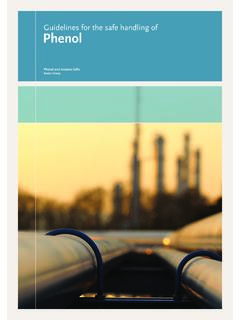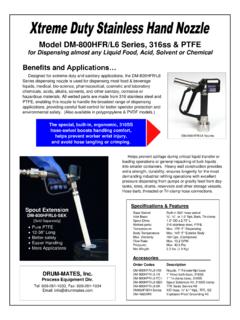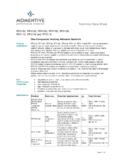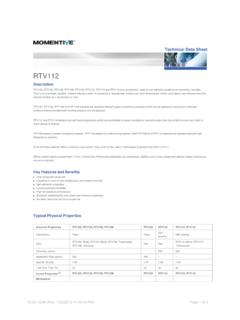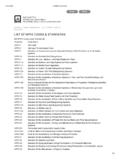Transcription of METHACRYLIC ACID SAFE HANDLING MANUAL
1 COPYRIGHT. Methacrylate Producers Association, Inc. and Methacrylates Sector Group of the European chemical Industry Council (2008). This work is protected by copyright. The Methacrylate Producers Association (MPA) and the Methacrylates Sector Group of the European chemical Industry Council (CEFIC), which are the owners of this copyright, hereby grants a nonexclusive royalty-free license to reproduce and distribute this work, subject to the following limitations: 1. The work must be reproduced in its entirety, without alterations. 2. All copies of the work must include a cover page bearing MPA's and CEFIC's notice of copyright. 3. Copies of the work may not be sold or reproduced on the Internet. INTRODUCTION. This MANUAL provides general information on the safe HANDLING of METHACRYLIC acid and dealing with specific hazards in an appropriate manner. These hazards include health risks, environmental risks, and the potential of uncontrolled polymerization.
2 Properties and characteristics quoted in this MANUAL refer to METHACRYLIC acid with a minimum content of 99 percent pure. They conform to specifications reported in the technical information bulletins issued by METHACRYLIC acid manufacturers. Some of the physical data might be subject to minor changes due to variable concentrations of natural impurities. Please read this entire MANUAL before HANDLING METHACRYLIC acid or before designing a storage system for METHACRYLIC acid. All preventive measures described in this MANUAL must be followed to minimize the risks associated with this substance. PREFACE. This MANUAL is a publication of the Methacrylate Producers Association, Inc. (MPA) and the Methacrylates Sector Group of the European chemical Industry Council (CEFIC) and represents industry best practice. It provides general information to METHACRYLIC acid users about the unique hazards associated with HANDLING this chemical and measures to be followed to protect human health, equipment, and the environment.
3 METHACRYLIC acid hazards include its corrosivity, combustibility, and its potential for unanticipated, uncontrolled, and rapid polymerization. Read and familiarize yourself with this entire MANUAL before using the information it contains. Also, thoroughly review your supplier's Material Safety Data Sheet for METHACRYLIC acid before working with it. Additional information is available in the publication entitled OECD SIAR METHACRYLIC Acid (CAS No. 79-41-4) , 2003. If you have any questions or need more detailed information, you should contact your METHACRYLIC acid supplier. This MANUAL was prepared by the following companies that are members of MPA and/or CEFIC: BASF. SE (European Union) CYRO Industries (United States), Arkema Inc. (United States), Arkema France (France), Lucite International (United States, United Kingdom), Repsol Qu mica, (Spain), Rohm and Haas Company (United States) and Evonik R hm GmbH (Germany). For further information contact: Methacrylate Producers Association, Inc.
4 17260 Vannes Court Hamilton, VA 20158. Methacrylates Sector Group of the European chemical Industry Council Avenue van Nieuwenhuyse, 4-B 1. B-1160 Brussels Belgium Although MPA and CEFIC believe that the information contained in this MANUAL is factual, it is not intended as a statement of legal requirements with respect to HANDLING METHACRYLIC acid. Consult with legal counsel and/or appropriate government authorities to ensure compliance with local, regional, national, and international laws and regulations. It is the customer's responsibility to ensure proprietary rights and existing laws are observed. No warranty or representation, either expressed or implied, is made with respect to any or all of the content of this document and neither MPA nor CEFIC nor its members assume any legal responsibility. TABLE OF CONTENTS. Section Title Page 1 NAMES .. 1. 2 PROPERTIES OF METHACRYLIC ACID .. 1. Grades of METHACRYLIC Acid .. 1. Properties and Characteristics of Glacial METHACRYLIC Acid.
5 1-2. 3 TRAINING AND JOB SAFETY.. 3. 4 INSTABILITY AND REACTIVITY HAZARDS .. 3. Polymerization .. 3. Overheating and Photo-initiation .. 3. Contamination .. 4. Corrosion .. 4. Inhibitor Depletion .. 4. Inhibitor Deactivation/Oxygen Depletion .. 4. Polymerization Detection .. 5. Effect of Freezing .. 5. High Temperature Decomposition .. 5. 5 RESPONSE TO UNCONTROLLED POLYMERIZATION .. 6. 6 THAWING OF FROZEN METHACRYLIC ACID .. 7. Thawing Frozen Drums/IBCs/TOTES .. 7. Thawing Frozen Bulk Containers .. 8. Thawing Plant Equipment .. 8. 7 HEALTH CONCERNS .. 9. Toxicity .. 9. First Aid .. 9. Contact with the Eyes .. 10. Inhalation .. 10. Contact with Skin .. 10. Ingestion .. 10. Industrial Hygiene .. 10. Personal Protective Equipment Guidelines .. 11. All Personnel .. 11. Routine Work .. 11. Non-Routine Work .. 11. Emergencies .. 12. 8 FIRE AND EXPLOSION HAZARD .. 12. Special Hazards .. 12. 9 STORAGE AND HANDLING .. 13. DRUM/IBC/TOTE STORAGE .. 13. Drum/IBC/Tote 13.
6 Drum/IBC/Tote Emptying .. 13. Drum/IBC/Tote Disposal .. 14. Bulk Storage .. 14. Materials of 14. Pressure Relief .. 15. Temperature Control .. 15. Pumps and Transfer Lines .. 16. i Section Title .. Page 10 SHIPPING .. 17. General .. 17. Unloading Sites .. 17. Procedures for Unloading Tank Trucks .. 18. Procedures for Unloading Rail Cars .. 19. Transportation Incidents .. 20. Personnel Protective Equipment with Bulk Containers .. 20. Thawing Shipping Containers .. 20. 11 ENVIRONMENTAL CONSIDERATIONS .. 20. Waste Disposal .. 20. Spill and Leak Control .. 21. Air Emissions .. 21. 12 APPENDIX .. 22. Key to Symbols in Figures 12-1, 12-2 and 12-3 .. 22. Example of a METHACRYLIC Acid Storage Facility .. 23. Example of a METHACRYLIC Acid Storage Tank Temperature Control 23. Example of a METHACRYLIC Acid Pump Loop .. 24. ii 1. NAMES. chemical Name METHACRYLIC acid Common Name METHACRYLIC acid Synonyms 2- METHACRYLIC acid -Methyl acrylic acid 2-Propenoic acid, 2-methyl 2-Propenoic acid, -methyl CAS Registry Number 79-41-4.
7 EINECS Number 201-204-4. chemical Formula CH2=C(CH3)COOH. UN Number 2531. IMDG-/ICAO-Class 8. ADA/RID Orange plate 89/2531. ADR/RID-Classification 8. 2. PROPERTIES OF METHACRYLIC ACID. GRADES OF METHACRYLIC ACID. Glacial METHACRYLIC acid is a refined grade of METHACRYLIC acid and contains monomethyl ether of hydroquinone (MEHQ, CAS 150-76-5) as its inhibitor. Note that MEHQ is also known as para- methoxyphenol (PMP) and 4-Hydroxyanisole (HA). Grades are available with different levels and types of inhibitor. Specific information is available upon request from producers. PROPERTIES AND CHARACTERISTICS OF GLACIAL METHACRYLIC ACID. The following values were taken from DIPPR (Design Institute for Physical Properties) where possible. DIPPR is a subsection of AIChE and specializes in compiling physical property data banks for various chemicals. The following is the most current information at the time of publication. Contact a producer for more up-to-date information or more detailed information about the properties of the grade of METHACRYLIC acid.
8 Properties Values/Information Notes Molecular Weight G1. Physical State Liquid above 15 C (59 F) G1. Odor Sharp, acrid, detectable at approx. ppm F. Color Clear and colorless Solubility in Organic Solvents Soluble in most solvents Light Sensitivity Light promotes polymerization Hygroscopicity Very hygroscopic Water Solubility Totally miscible above 16 C (61 F) F. Flammable Limits % by volume in air at 760 mm Hg (LEL), (UEL) G1. minimum oxygen, calculated, % C12. Flash Point, Tag Closed Cup, DIN 51758 67 C (153 F) G1. Abel-Pensky, EN 22719 77oC (171oF) G2. Autoignition Temperature, approximate 435 C (815 F) G1. Freezing Point, BS 523:1964 15 C (59 F) G1. Vapor pressure, at 20 C (68oF), mbar (mmHg) ( ) G1. at 40oC (104oF), mbar (mmHg) ( ). at 60oC (140oF), mbar (mmHg) ( ). at 100oC (212oF), mbar (mmHg) ( ). at 120oC (248oF), mbar (mmHg) (188). 1. Properties Values/Information Notes Boiling Point, at 760 mm Hg (1013 mbar), DIN 51751 161 C (322 F) G1. at 50 mm Hg (67 mbar), DIN 51751 90 C (194 F).
9 At 10 mm Hg (13 mbar), DIN 51751 60 C (140 F). Equilibrium Concentration in air, calculated G1. at 20 C (68oF), ppm (mg/m3) 878 (3369). at 25 C (77oF), ppm (mg/m3) 1300 (4988). at 30 C (86oF), ppm (mg/m3) 1905 (7309). Critical Volume, L/mol (ft3/lb-mole) ( ) G1. Critical Pressure, mbar (psia) 47900 (695) G1. Critical Temperature, oC (K) 389 (662) G1. Specific Gravity at 20 C (68oF), g/cm3, DIN 53169 G1. Liquid Coefficient of Thermal Expansion, units of specific G3. gravity/oC. Specific Gravity of Vapor (air = 1) C13. Liquid Viscosity at 20 C (68oF), cp (mpas) G1. Surface Tension at 20oC (68oF), mN/m G2. Heat of Combustion at 25 C (77oF), kJ/kg 23000 G1. Heat of Vaporization, kcal/mol (kJ/mol) ( ) G1. Heat of Fusion, kcal/mol (kJ/mol) ( ) G4. Heat of Polymerization, kJ/kg 768 G5. Heat of Neutralization, kJ/kg 660 U. Specific Heat, at 20 C (68oF), kJ/kg, K G1. at 100oC (212oF), kJ/kg, K Dissociation Constant at 25oC (77oF) x 10 -5 G6. Electrical Conductivity (range of estimates), mho/cm2 4-10 x 10-5 (0% H20) F.
10 Refractive Index, nD25 G1, 7. nD20 G8. National Fire Protection Assoc. Hazard Classification 3-2-2 G9. NPCA HMIS Rating 3-2-2 G10. Electrical Group Classification,IEC-78-8; NEC (US) T2(300-450oC); Unclassified/Class I, Group D G. chemical Oxygen Demand (COD), weight oxygen/wt MAA C14. Biological Oxygen Demand (BOD5), wt oxygen/wt MAA G11. pH of METHACRYLIC Acid in Water 100 ppm METHACRYLIC Acid F. 1000 ppm METHACRYLIC Acid F. 10,000 ppm METHACRYLIC Acid F. 100,000 ppm METHACRYLIC Acid F. Data Quality: G-Good, Reliable public source; F-Fair, Unverifiable or non-public source; U-Unknown source; C-Calculated by standard methods. Sources: 1 DIPPR. 2 OECD/EU Risk Assessment 3 chemical Properties Handbook-Coefficient of Thermal Expansion of Liquid: Organic Compounds. 4 Knovel Critical Tables Physical Constants and Thermodynamics of Phase Transitions 5 Heats of Polymerization of Acrylic Acid and Derivatives, Evans and Tyrrall, Journal of Polymer Science, Vol 2, No 4, 1947.

